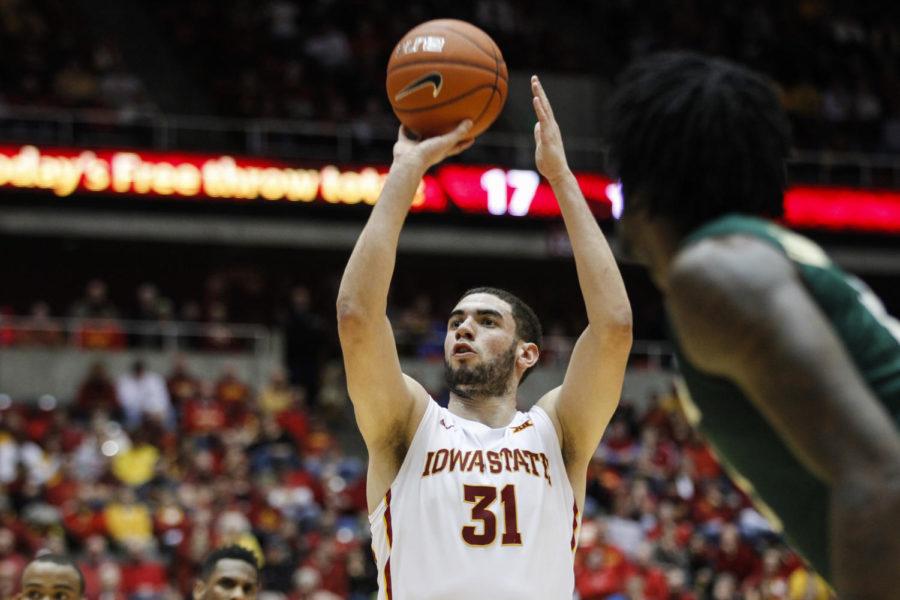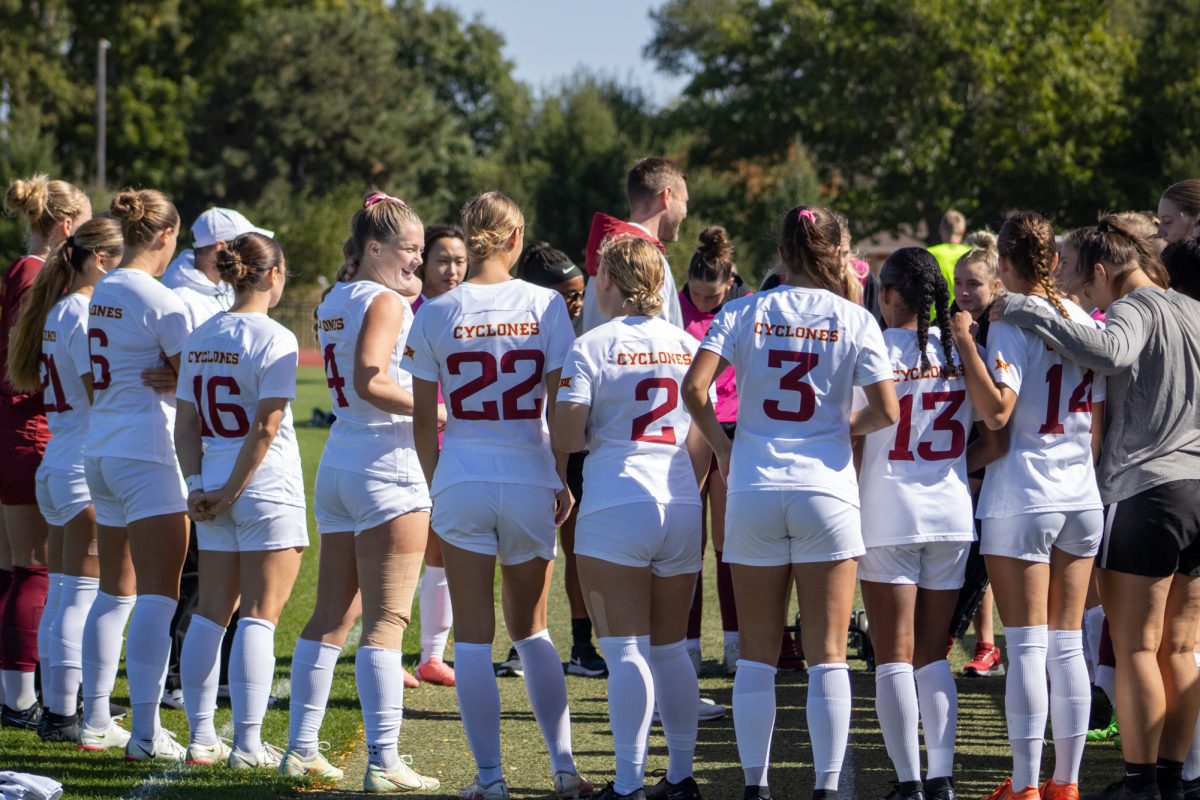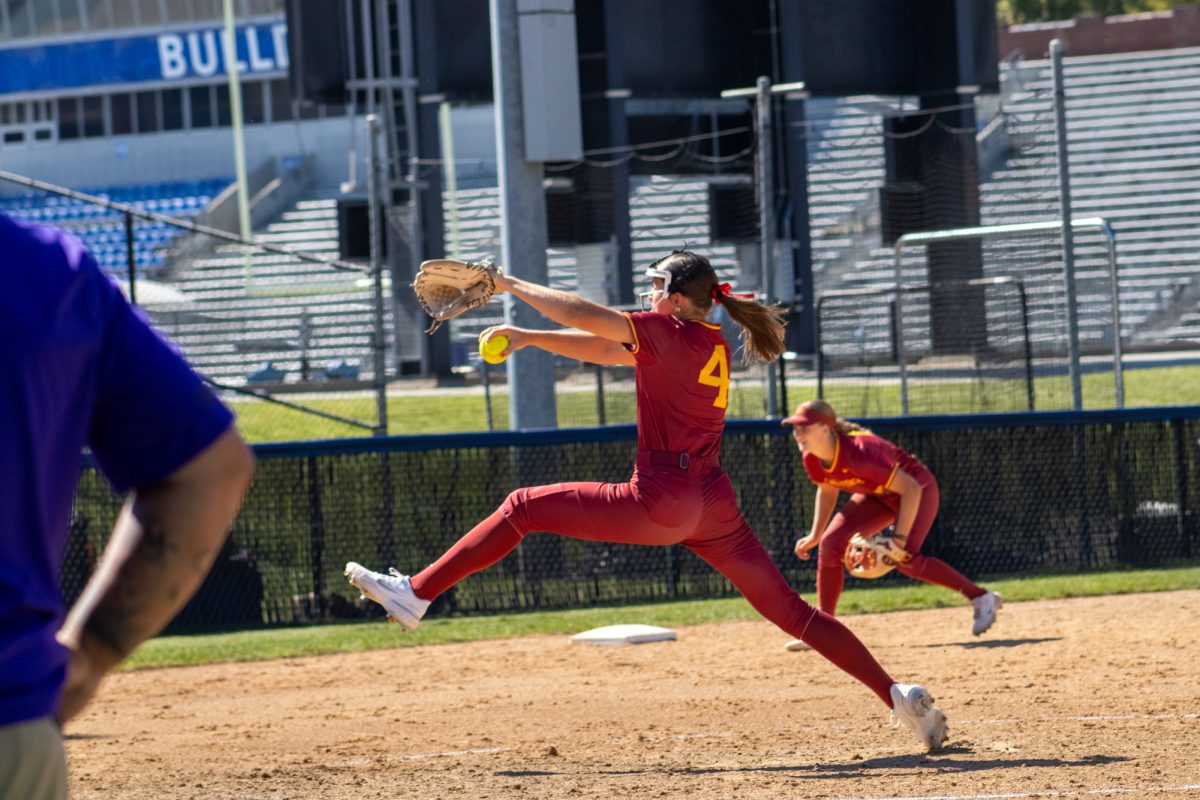Numbers Never Lie: ISU strategists seek truth in analytics
Kelby Wingert/Iowa State Daily
Junior forward Georges Niang attempts a free throw against Baylor on Feb. 25. The Bears took down the Cyclones 79-70. Niang had 14 points and made 6-of-6 free throws.
March 4, 2015
The game of basketball has changed.
The sport’s structure and its rules remain basically the same as they have always been, save for a tweak here and a slight adjustment there, which is common in the evolution of every sport. Yet, with the dawning of the “moneyball” era in Oakland and the subsequent spread of statistical analysis throughout sports at both the professional and collegiate levels, the way basketball is analyzed by those who are a part of it has been drastically altered.
Fresh numbers pour in not just every year, but after every contest, constantly forming and reforming what teams know about not only their opponents, but also themselves. The greatest edge to be had in the game of college basketball today beyond recruiting the best players (see Kentucky and its undefeated record), lies in the interpretation and utilization of that information toward the making of value decisions.
“We definitely use [advanced statistical analysis] in each game-by-game prep as far as figuring out opponents’ strengths and weaknesses and then tailoring the game plan to exploit some weaknesses and take away from strengths,” said ISU assistant coach Charlie Henry, who spearheads the use of advanced stats for Iowa State.
Then we use the season-long [numbers] to really evaluate ourselves, to know ourselves better — how we are executing, where we stack against teams in our league as opposed to the rest of the country.”
The amount of information available is so massive and the different ways to quantify it are so numerous that it is important to narrow strategy-based analytics into a frame of reference that is actually usable. Henry said it is specification and not simplification that is the key.
For instance, Iowa State has struggled defensively throughout the season. Defensive rating is a statistical category that measures points allowed per 100 possessions. Adjusted defensive rating takes into account when and where games were played and who they were played against to create a better indicator of a team’s true defensive prowess.
However, simply understanding that Iowa State — after suffering an 11-point loss at Oklahoma on Feb. 9 — had a season-long adjusted defensive rating on par with the likes of Cleveland State and South Dakota State was not enough. In that case, the numbers told Henry and the Cyclones their defense was relatively awful. The goal then became finding the numbers that would help them remedy that issue.
“We don’t just look at our defensive efficiency,” Henry said. “We also look at sequence — how we defend after a made basket, a missed basket, a turnover or a stop in play.”
One thing that the numbers have made clear to Henry is that Iowa State’s defensive struggles have been tethered tightly to an inability to guard the 3-point line. The strategic puzzle that Henry, ISU coach Fred Hoiberg and the rest of the ISU coaching staff are trying to answer deals with how that element of their defense can improve without weakening other aspects of their game.
“There is always a give and take and there is a cause and effect for every decision you make. We want to protect the paint first, but we also want to get out to shooters and that’s what you’re looking at,” Henry said. “Usually, if you’re not protecting the paint, it’s going to lead to higher percentages on your two-point field goal percentage defense and you’re probably going to send guys to the free-throw line because your help is late.”
Such a result would be unacceptable to the ISU coaching staff. First, if the Cyclones become more vulnerable inside, they invite teams to attack them closer to the basket, which inherently produces a higher rate of success because shots are easier to make the closer they occur to the hoop.
Second, Iowa State runs an eight-man rotation, which means foul trouble for one or two Cyclones is cause for substantial concern and can disrupt other areas of play. For instance, when Monté Morris — Iowa State’s only true point guard — went to the bench halfway through the second half at West Virginia, it led to turnover problems against the WVU press and a near loss due in part to Morris’ absence.
Finally, putting teams on the free-throw line more frequently affects Iowa State’s overall offensive game plan, one the team wants to employ night in and night out.
“We have one of the lowest free-throw rates in the country and with our style of play, we want to run. We want to wear teams down,” Henry said. “That’s important because we understand that when you send a team to the free-throw line, now all of the sudden you know have to work against a set defense.”
Operating on the assumption that most teams at the collegiate level are well-coached enough that they are attempting mostly quality shots from beyond the arc, Henry said that the answer lies in limiting opponents’ 3-point attempts.
“If you’re giving up a lot of attempts, you’re probably going to give up 3’s,” Henry said. “So we want to limit attempts, get out close to shooters, make them bounce it and play in the in-between game.”
Advanced statistics have helped zero in on the problem, but that is where their utility ends. The ISU players are still tasked with implementing the strategy.
The Cyclones have allowed 22.2 3-point attempts per contest during their last five games, which is up from their season average of 21.3 attempts allowed per contest. Iowa State has also allowed an opposing 3-point field goal percentage of 37.8 percent during the last five, which is up from its season average of 36.2 percent.
Guard Naz Long said the analytics-based strategy that the team employs gets even more specific than Henry’s example displays. Strategies are not only built season to season and game to game, but occasionally during a game itself.
If Hoiberg recognizes a specific weakness within an opponent’s defense that was exploited a few times in the first half, then at halftime he will emphasize specific shots off of specific play actions to lean harder on that weakness in hopes of crumbling the opposing defense entirely.
Perhaps the clearest example of this came in Iowa State’s first contest against Texas at Hilton on Jan. 26 when the Cyclones scored 89 points and built a 21-point lead midway through the second half.
“Our best chance of scoring on that type of zone was hitting the high post and looking high-low with Jameel [McKay] and George [Niang],” Long said. “The coaches break down that type of statistical stuff and we attack it. The numbers don’t lie. They look at everything.”
Despite the complexities presented by in-depth statistical analysis as a basis for formulating strategy, Henry said there are still godfather types of statistics that are indicators of success or failure in every game played.
“You look at any box score and you can probably tell who won just by taking a look at four things,” Henry said. “[Those are] free throws, 3-pointers, field goal percentage defense and the rebounds you’re giving up. We’re always looking at those four things.”
It is the breaking down of those four categories to a more specific and usable level, connecting them with each other and other aspects of the game, then building it all into Iowa State’s overarching strategies of high pace and sharing the ball that help to create minor edges against opponents. Those marginal advantages have contributed substantially to the long-term success Iowa State has enjoyed during the past four seasons.







